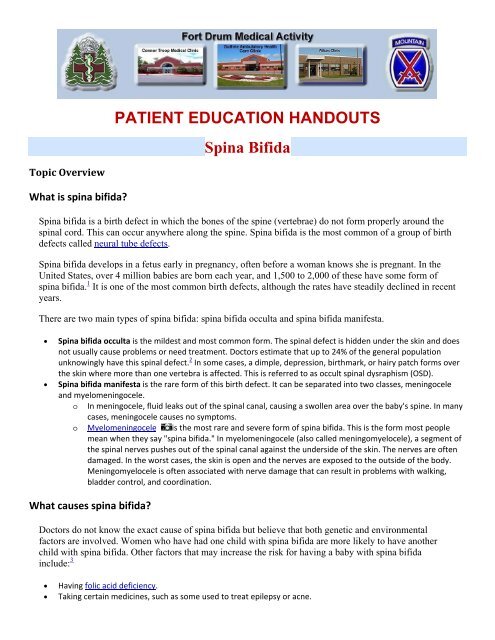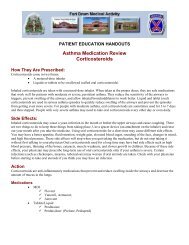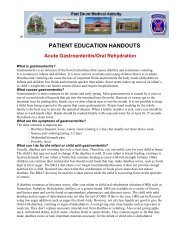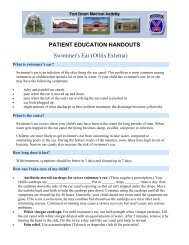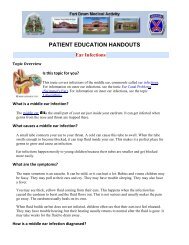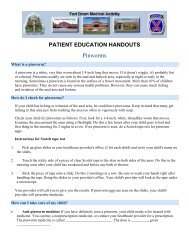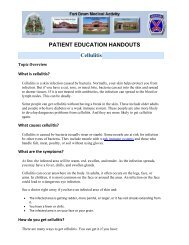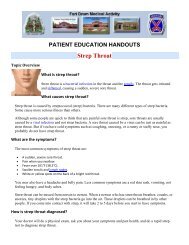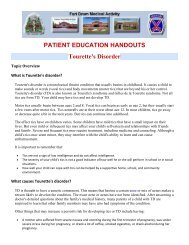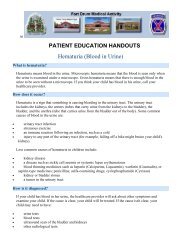PATIENT EDUCATION HANDOUTS Spina Bifida
PATIENT EDUCATION HANDOUTS Spina Bifida
PATIENT EDUCATION HANDOUTS Spina Bifida
- No tags were found...
You also want an ePaper? Increase the reach of your titles
YUMPU automatically turns print PDFs into web optimized ePapers that Google loves.
<strong>PATIENT</strong> <strong>EDUCATION</strong> <strong>HANDOUTS</strong><strong>Spina</strong> <strong>Bifida</strong>Topic OverviewWhat is spina bifida?<strong>Spina</strong> bifida is a birth defect in which the bones of the spine (vertebrae) do not form properly around thespinal cord. This can occur anywhere along the spine. <strong>Spina</strong> bifida is the most common of a group of birthdefects called neural tube defects.<strong>Spina</strong> bifida develops in a fetus early in pregnancy, often before a woman knows she is pregnant. In theUnited States, over 4 million babies are born each year, and 1,500 to 2,000 of these have some form ofspina bifida. 1 It is one of the most common birth defects, although the rates have steadily declined in recentyears.There are two main types of spina bifida: spina bifida occulta and spina bifida manifesta.• <strong>Spina</strong> bifida occulta is the mildest and most common form. The spinal defect is hidden under the skin and doesnot usually cause problems or need treatment. Doctors estimate that up to 24% of the general populationunknowingly have this spinal defect. 2 In some cases, a dimple, depression, birthmark, or hairy patch forms overthe skin where more than one vertebra is affected. This is referred to as occult spinal dysraphism (OSD).• <strong>Spina</strong> bifida manifesta is the rare form of this birth defect. It can be separated into two classes, meningoceleand myelomeningocele.oIn meningocele, fluid leaks out of the spinal canal, causing a swollen area over the baby's spine. In manycases, meningocele causes no symptoms.o Myelomeningocele is the most rare and severe form of spina bifida. This is the form most peoplemean when they say "spina bifida." In myelomeningocele (also called meningomyelocele), a segment ofthe spinal nerves pushes out of the spinal canal against the underside of the skin. The nerves are oftendamaged. In the worst cases, the skin is open and the nerves are exposed to the outside of the body.Meningomyelocele is often associated with nerve damage that can result in problems with walking,bladder control, and coordination.What causes spina bifida?Doctors do not know the exact cause of spina bifida but believe that both genetic and environmentalfactors are involved. Women who have had one child with spina bifida are more likely to have anotherchild with spina bifida. Other factors that may increase the risk for having a baby with spina bifidainclude: 3• Having folic acid deficiency.• Taking certain medicines, such as some used to treat epilepsy or acne.
• Excessive use of alcohol.• Exposure to certain chemicals.• Exposure to high temperatures.• Having diabetes.• Being obese.What are the symptoms?Symptoms of spina bifida depend on the severity of the condition. In spina bifida occulta, there may be nosymptoms or only a dimple, depression, birthmark, or hairy patch over the affected vertebrae.In spina bifida manifesta, there may be swelling over the affected spine or even exposed spinal nerves onthe back. If the nerves are damaged, the child may have problems with walking, bladder and bowel control,and coordination. The child may experience numbness and paralysis in the legs, and less commonly in thearms.How is spina bifida diagnosed?The maternal serum triple or quadruple screen uses a blood sample from the mother to screen for fetalabnormalities, including neural tube defects. When tests show elevated levels of alpha-fetoprotein (AFP),neural tube defects such as spina bifida are more likely. A high-resolution fetal ultrasound may then bedone to try to determine whether the fetus has any visible abnormalities. Usually fetal ultrasound can onlydetect signs of severe spina bifida (manifesta).Amniocentesis usually is also done when the maternal serum triple or quadruple screen indicates a highlevel of AFP. Amniocentesis allows health professionals to measure the levels of substances in theamniotic fluid of the fetus. Because abnormalities related to spina bifida are not always revealed by fetalultrasound, an amniocentesis may be done even without first having an ultrasound or if an ultrasound isdone and appears normal.<strong>Spina</strong> bifida is usually diagnosed when amniocentesis results confirm heightened levels of AFP and theenzyme acetylcholinesterase (ACH) and the ultrasound shows fetal abnormalities in the spine that arespecific to spina bifida.After birth, spina bifida may be diagnosed by the appearance of the back. An X-ray, MRI, or CT scan maybe done to evaluate suspected spina bifida.Can spina bifida be prevented?Having enough folic acid (a B vitamin) in your diet is an important part of preventing spina bifida andother neural tube defects. But to be effective, folic acid needs to be consumed before a baby is conceived.To reduce the risk of spina bifida, most women need to consume 400 mcg (micrograms) of folic acid aday. Women who are at risk (such as those who have already had a child with spina bifida) should take4,000 mcg of folic acid a day. 4 You can get enough folic acid by eating foods rich in folic acid, such asavocados, black beans, and asparagus, or by taking a vitamin pill. Since 1998, the United Statesgovernment has required that foods made from grains and sold in the United States be supplemented withfolic acid to help reduce the risk of spina bifida.If you take medicine for epilepsy or acne, talk with your doctor before you become pregnant about the riskof having a baby with spina bifida.
Do not drink alcohol while you are pregnant. No amount of alcohol is considered safe during pregnancy. Achild born to a woman who drank alcohol during pregnancy has an increased risk for spina bifida, as wellas other problems.Avoid exposure to excessive heat, such as saunas or soaking in a very hot bath, during the first weeks ofyour pregnancy. A high fever during the first weeks of pregnancy could also cause your baby to developspina bifida.How is it treated?Treatment for spina bifida depends on how severe the condition is. Surgery may be done to repair thespinal defect or to correct complications such as hydrocephalus. Physical therapy, braces, and othertreatments may be necessary to help children who have problems resulting from nerve damage.Learning about spina bifida:Being diagnosed:Getting treatment:Living with spina bifida:• What is spina bifida?• What are the symptoms?• What are the types of spina bifida?• How is spina bifida diagnosed?• What is the treatment for spina bifida?• How can I help my child with spina bifida?Author: Shannon Erstad, MBA/MPH Last Updated: May 10, 2007Medical Review: Michael J. Sexton, MD ‐ PediatricsColin Chalk, MD, CM, FRCPC ‐ Neurology______________________________________________Reviewed 9 June 2008


